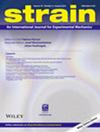半侵入式残余应力测量方法中总不确定性分析的进展
IF 2.4
3区 材料科学
Q2 MATERIALS SCIENCE, CHARACTERIZATION & TESTING
引用次数: 1
摘要
准确表征不同长度范围内残余应力分布的能力,尤其是深入工程零件的能力,在评估结构完整性方面发挥着重要作用。测量工程部件深处残余应力场的两种最常用技术包括中子衍射(ND)和深孔钻探(DHD)。由于测量取决于几个物理量,因此容易出错。误差或不确定性可能会变得很大,并影响结果的适用性。尽管是非侵入性的,但中子衍射技术既不容易获得,也不便携,仅限于约60毫米厚的样品;与结果相关联的误差在更大的飞行路径上变得不可接受。此外,ND技术中通常使用代表工程组件的实体模型。相比之下,DHD技术是便携式的,并且以高空间分辨率测量残余应力。考虑到DHD方法的各个阶段,应用误差传播技术开发了误差分析程序,并成功应用于不同的DHD测量。在误差分析程序中,还没有考虑到由于在DHD程序中创建参考孔而产生的塑性影响这一基本特征。本文简要介绍了如何确定初始参考孔产生的不确定性。本研究量化了钻井过程中塑性的影响。该误差与其他误差源相结合,并公式化以确定总误差。使用增量DHD技术测量焊接圆盘中的复杂三轴残余应力场,并使用研究中开发的误差分析方法将测量数据用于说明总误差。本文章由计算机程序翻译,如有差异,请以英文原文为准。
Advances in analysis of total uncertainties in a semi‐invasive residual stress measurement method
The ability to characterise residual stress distribution accurately and over different length scales, particularly deep into an engineering part, plays a significant role in assessing structural integrity. Two most commonly used techniques to measure residual stress fields deep into engineering components include neutron diffraction (ND) and deep‐hole drilling (DHD). As the measurements depend on several physical quantities, they are susceptible to error. The error or uncertainties may turn substantial and compromise the suitability of the results. Although noninvasive, the neutron diffraction technique is neither readily available nor portable and is limited to approximately 60‐mm‐thick specimen; errors associated with results become unacceptable at greater flight paths. Moreover, a mock‐up representing the engineering component is normally used in the ND technique. In contrast, the DHD technique is portable and measures residual stresses with high spatial resolution. An error propagation technique was applied to develop an error analysis procedure taking into consideration various stages of the DHD method and successfully applied to different DHD measurements. An essential feature comprising the effect of plasticity due to the creation of reference hole in the DHD procedure has not yet been taken into account in the error analysis procedure. This paper briefly describes how the uncertainties due to the creation of the initial reference hole can be determined. The effect of plasticity in the drilling procedure is quantified in this study. This error is combined with other sources of error and formulated to determine the total error. An incremental DHD technique was used to measure the complex triaxial residual stress field in an as‐welded circular disc, and the measured data were used to illustrate the total error using the error analysis method developed in the study.
求助全文
通过发布文献求助,成功后即可免费获取论文全文。
去求助
来源期刊

Strain
工程技术-材料科学:表征与测试
CiteScore
4.10
自引率
4.80%
发文量
27
期刊介绍:
Strain is an international journal that contains contributions from leading-edge research on the measurement of the mechanical behaviour of structures and systems. Strain only accepts contributions with sufficient novelty in the design, implementation, and/or validation of experimental methodologies to characterize materials, structures, and systems; i.e. contributions that are limited to the application of established methodologies are outside of the scope of the journal. The journal includes papers from all engineering disciplines that deal with material behaviour and degradation under load, structural design and measurement techniques. Although the thrust of the journal is experimental, numerical simulations and validation are included in the coverage.
Strain welcomes papers that deal with novel work in the following areas:
experimental techniques
non-destructive evaluation techniques
numerical analysis, simulation and validation
residual stress measurement techniques
design of composite structures and components
impact behaviour of materials and structures
signal and image processing
transducer and sensor design
structural health monitoring
biomechanics
extreme environment
micro- and nano-scale testing method.
 求助内容:
求助内容: 应助结果提醒方式:
应助结果提醒方式:


